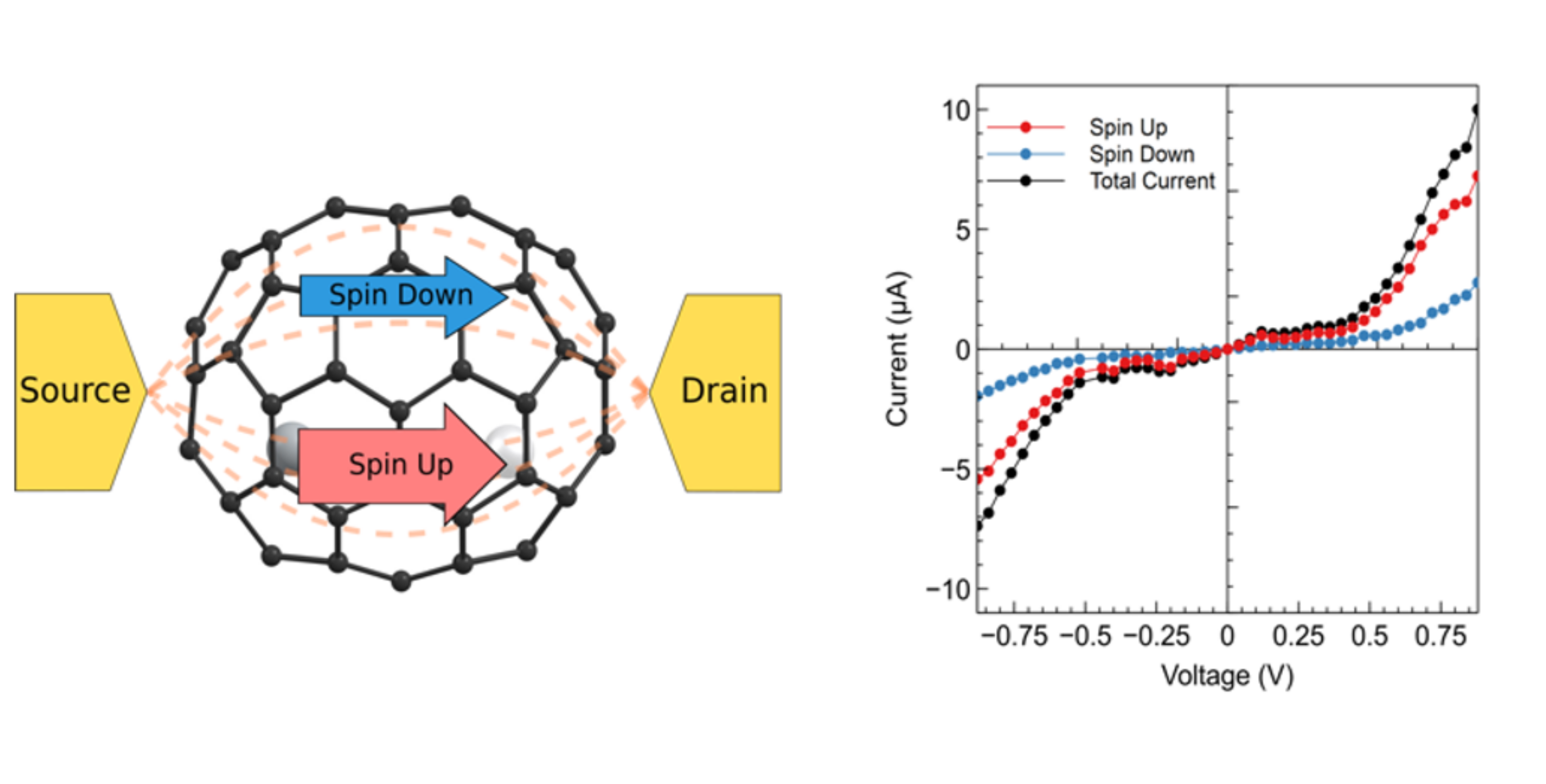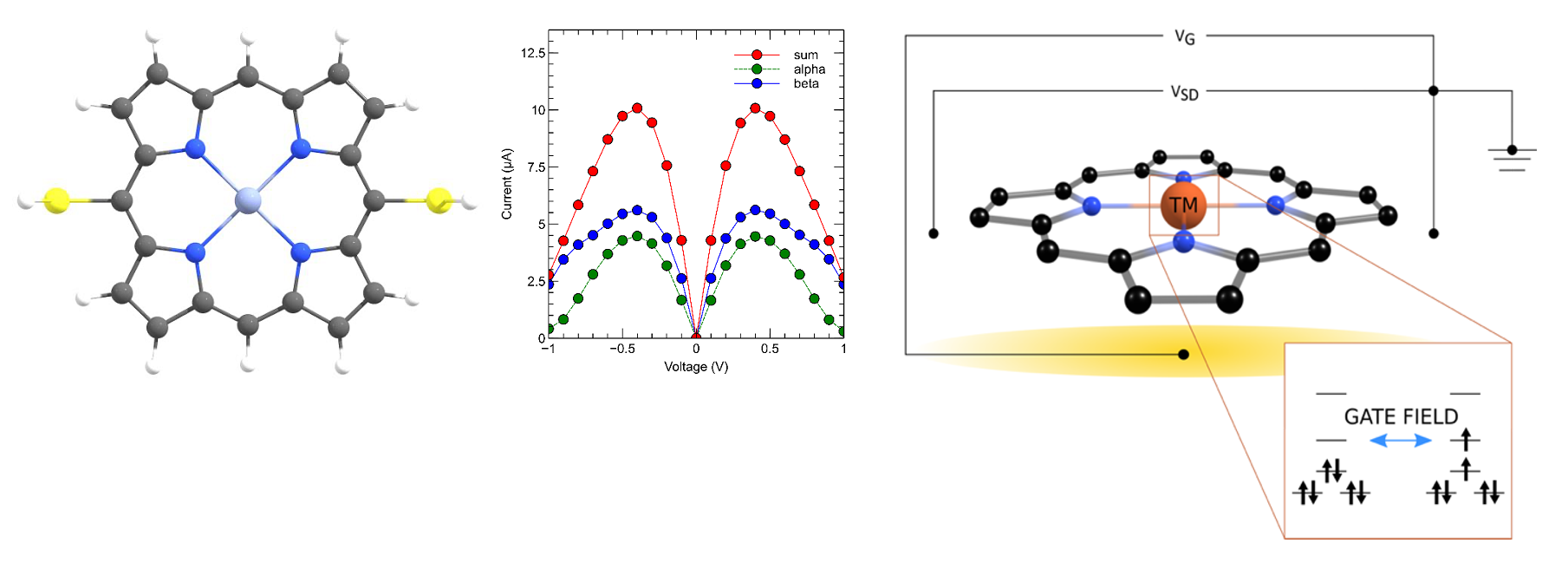Molecular electronics
One of the alternatives for how to make computers faster and smaller is molecular electronics that pursues the idea of single molecules acting as electronic components. Independently, molecules can also act as molecular switches and motors. We try to fuse these two fields by designing switching molecular electronics.
Fullerene switches
We designed an electric-field driven single-molecule switch that is based on MX@C70 molecules, where MX is a dipolar molecule enclosed in the fullerene cage.1 In such a system, an external electric field allows to flip the MX dipole between two local minima (LM and LM’). The minima are separated by an energy barrier, so the system retains its state when the field is off, thus making it a switch.
Fullerene memristors
When the above MX@C70 switch is connected to electrodes, it acts as a memristor, which is an electronic component that retains information about the past current flow, or the voltage previously applied to it. As illustrated, a high voltage applied to electrodes switches the MX dipole that causes changes in the conductivity of the system, that can be in turn measured using low voltage at electrodes. The switching of MX by a higher voltage leads to a hysteresis on I/V curves of the MX@C70 system that closely resembles those of bulk memristors.

Memristors are highly important components for neuromorphic computer architecture. The present standard (the von Neuman architecture) utilizes separate processing unit (CPU) and memory (RAM) components. This causes a large bottleneck in the communication between the CPU and RAM as well as an additional energy consumption – about 40 % of the total amount. Neuromorphic computing, in which the processing unit acts both as a CPU and as a RAM, is an attractive alternative to von Neumann architecture. Molecular memristors thus have a great potential.
Spin-filtering memristor aka spinristor

Presently, we focus on introducing spin-filtering function through open-shell metal atoms in conductive molecules. Our initial targets include metalloporphyrins, helicenes, and endohedral fullerenes. By combining a spin-filtering with a field-induced spin-crossover and isomerization, we can precisely control the transmission properties of these molecules. Our ultimate vision is to apply these findings in areas such as data storage and neuromorphic computing, where these molecular systems can revolutionize the field.

References:
1. Jaroš, A.; Bonab, E. F.; Straka, M.; Foroutan-Nejad, C. Fullerene-Based Switching Molecular Diodes Controlled by Oriented External Electric Fields. J. Am. Chem. Soc. 2019, 141 (50), 19644–19654. https://doi.org/10.1021/jacs.9b07215
2. Tučková, L.; Jaroš, A.; Foroutan-Nejad, C.; Straka, M. A Quest for Ideal Electric Field-Driven MX@C₇₀ Endohedral Fullerene Memristors: Which MX Fits the Best? Phys. Chem. Chem. Phys. 2023, 25, 14245–14256. https://doi.org/10.1039/D3CP01149F
3. Zhang, K.; Wang, C.; Zhang, M.; Bai, Z.; Xie, F.-F.; Tan, Y.-Z.; Guo, Y.; Hu, K.-J.; Cao, L.; Zhang, S.; Tu, X.; Pan, D.; Kang, L.; Chen, J.; Wu, P.; Wang, X.; Wang, J.; Song, Y.; Wang, G.; Song, F.; Ji, W.; Xie, S.-Y.; Shi, S.-F.; Reed, M. A.; Wang, B. A Gd@C₈₂ Single-Molecule Electret. Nat. Nanotechnol. 2020, 15, 1019–1024. https://doi.org/10.1038/s41565-020-00778-z
4. Li, J.; Hou, S.; Yao, Y.-R.; Zhang, C.; Wu, Q.; Wang, H.-C.; Zhang, H.; Liu, X.; Tang, C.; Wei, M.; Xu, W.; Wang, Y.; Zheng, J.; Pan, Z.; Kang, L.; Liu, J.; Shi, J.; Yang, Y.; Lambert, C. J.; Xie, S.-Y.; Hong, W. Room-Temperature Logic-in-Memory Operations in Single-Metallofullerene Devices. Nat. Mater. 2022, 21 (8), 917–923. https://doi.org/10.1038/s41563-022-01309-y
5. Jaroš, A.; Sasar, M.; Tučková, L.; Bonab, E. F. Spinristor: A Spin-Filtering Memristor. Adv. Electron. Mater. 2023, 9 (8), 2300360. https://doi.org/10.1002/aelm.202300360

